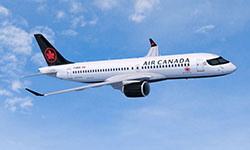
Air Canada is eagerly anticipating the arrival of the first of 45 Airbus A220-300s later this year. This is the newest aircraft to join the company’s fleet, which is one of the youngest in the industry and, by 2021, the average age of the mainline fleet will be 8.5 years. The A220 is revered for being quieter, for its ability to fly farther with less fuel, and for its reduction of greenhouse gas emissions compared to other narrow body aircraft.
Like the Boeing 787 Dreamliner, the fuel-efficient Airbus A220 has been hailed by many as a game changer in aircraft technology that has led many to believe that it’s also an excellent option for travellers who are conscious about leaving less of an environmental footprint when they fly.
The lighter aircraft, thanks to advances in aviation engineering that permit the use of lightweight advanced materials, such as carbon fiber and aluminum-lithium, along with advances in jet engine technology, play a key role in reducing fuel use.
Airbus A220 leads in fuel efficiency
The narrow body aircraft is built for performance. Air Canada plans to roll the 137-seat aircraft out across North America with its ability to fly farther on less fuel, averaging 20 per cent less fuel consumption per seat.
“Almost every operator of the A220 has exceeded fuel efficiency estimates and we expect to do the same when we begin operating this aircraft,” said Mark Galardo, Vice President of Network Planning at Air Canada.
Airbus A220 creates less greenhouse gas emissions
The lighter aircraft and Pratt & Whitney’s Geared Turbofan (GTF) engines combine to minimize fuel use and, impressively, operate cleaner and more efficiently to meet performance benefits including up to 20 per cent lower fuel consumption and a 75 per cent reduction in noise footprint compared to aircraft it replaces. With the aircraft and engines operating at a more efficient and optimal rate, the aircraft emits 20 per cent less carbon dioxide (CO2) and 50 per cent less Nitrogen oxides (NOx).
Airbus A220 is the quietest aircraft in its category
The Airbus A220 is about as quiet as common city noise and, actually, quieter than a car. When compared with other aircraft in its category, its noise level is 50 dBA lower. This notable reduction in noise pollution will be of particular interest and benefit for communities surrounding airports.
The A220: Eco-efficient from the moment it was designed
On top of being more fuel efficient and quieter than other aircraft in its class, the A220 was also conceived responsibly, with attention given to reduce the footprint of the production process, but also the after-life recoverability of the aircraft.
With environmental sustainability as a guiding principle, significant effort went in to maximizing energy and resources, eliminating hazardous substances and related toxic emissions, and enhancing the overall product recoverability rate.
How does the A220 achieve top status as the greenest commercial aircraft?
The A220’s evolution towards one of the greenest commercial aircrafts in the sky is thanks to advances in engine technology and the use of over 50% advanced materials that are lighter than previous generation ones.
Pratt & Whitney's GTF engines are designed to be cleaner, quieter, more powerful and more fuel-efficient than existing jet engines. A fundamental shift in jet engine architecture resulted in introducing a Fan Drive Gear System into the engines for new aircraft, including the A220. This innovative design helps the fans at the front of the engine spin three times slower than the compressor and turbine, thus using much less fuel than traditionally needed for jet engines. . The team at Pratt & Whitney evolved how their engine manages the bypass ratio, or the proportion of the air that bypasses the core versus the amount that goes through it, in turn making it operate more efficiently, cleanly and quietly.
Around one third of fuel burn gains come from the lightweight materials. The use of advanced aluminum for the main body and carbon fibre reinforced plastic for much of the wing and body, coupled with lighter paint and other materials together make the Airbus A220 a very lightweight aircraft.
Air Canada’s investment in a more environmentally sustainable fleet is not new. In 2014, the company began taking delivery of the Boeing 787 Dreamliner, the most modern commercial aircraft now in operation which is delivering an approximately 20 per cent improvement in fuel efficiency over the aircraft they replaced, and an aircraft considered by many interested in sustainable travel to be the best option for long haul flights.
Since 1990, Air Canada has increased its fuel efficiency 44.5 per cent, with a three per cent average annual improvement over the last seven years – double the global industry target of 1.5 per cent. Air Canada’s acquisition of the A220 is part of the the company’s promise to leave less behind.
